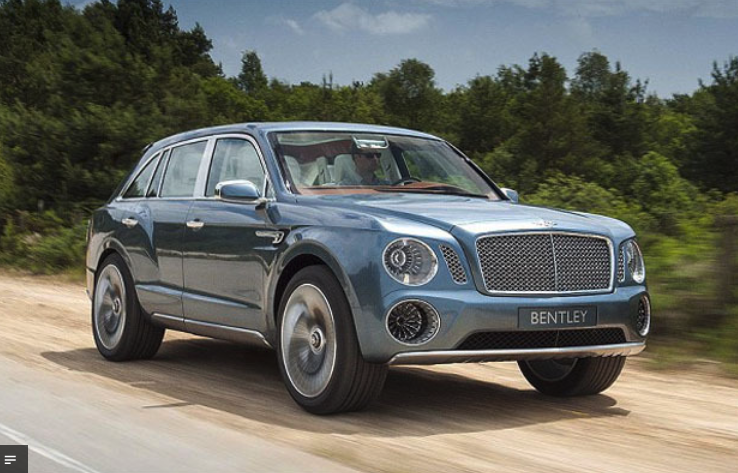Trends: Explaining the huge rise of luxury trucks and SUVs

Story by John LeBlanc
The concept of a modern luxury vehicle has definitely changed in recent times. Gone are the days when a “luxury car” meant a big four-door sedan or two-door coupe from the likes of Lincoln or Cadillac. Instead, the majority of today’s so-called luxury vehicles (those with prices over $50,000) are full-size pickup trucks and SUVs.
Based on a report from U.S.-based Wall Street Journal, eight of the 10 best-selling new vehicles priced over $50,000 last year in America were SUVs or trucks. With 25% of its sales coming from versions with prices above $50,000, the Ford F Series was the best-selling luxury vehicle — truck, SUV or car — in 2014. Only the BMW 5 Series and Mercedes-Benz E-Class cracked the top 10 list.
It’s easy to see how a new vehicle that can manage to play a practical role as a daily commuter, weekend warrior and loaded to the gills with all-leather interiors, full-on infotainment, and power-everything, has become so popular with well-off consumers looking for the best of both automotive worlds. But where did this trend of luxury trucks and SUVs come from?
Buyers have been moving from traditional passenger cars to larger, more practical vehicles since the first SUVs arrived in the 1960s, parallel with automakers smelling the allure of higher profits by simply adding luxury features to what were once purely utilitarian vehicles.
Arguably, the first luxury SUV was the 1963 Jeep Wagoneer. With traction at all four wheels, lots of room for passengers and their cargo and higher levels of creature comforts, the Jeep Gladiator truck-based Wagoneer established the template of the modern luxury SUV.
Still, up until the 1980s, the majority of buyers were opting for luxury station wagons, like the Ford Country Squire, as comfy-yet-practical transportation. The majority of contemporary SUVs sold were of the two-door nature, like the full-size truck-based Chevrolet Blazer and Ford Bronco, meant more for the fishing and hunting crowd than suburbanites. However, it wasn’t until Land Rover’s Range Rover (first seen in 1970) adopted a four-door body style in 1981, and added features like leather seats and automatic transmission in 1984, that the idea of an SUV as a luxury car started to gain traction with the wealthy. And the success of the Range Rover prompted other automakers to capitalize on the soaring popularity of SUVs by offering luxury versions of its mainstream SUV offerings.
In quick succession, we saw gentrified versions of plebeian SUVs like the Ford Expedition-based 1998 Lincoln Navigator and the Chevrolet Tahoe-based Cadillac Escalade the next year. Even the German luxury brands could not resist the lucrative profits of the luxury SUV segment. Mercedes-Benz launched its M-Class in 1997, with the first BMW X5 arriving two years later.
It may be easy to justify outlaying over $50,000 for an all-rounder like a luxe SUV. But buyers today also have no problem shelling out big bucks for fancy trucks too. And it all started with the 1955 Chevrolet Cameo Carrier.
Up until the 1950s, trucks were strictly used for commercial purposes as delivery vehicles or workhorses on farms. But the ‘55 Chevrolet Cameo Carrier was arguably the first pickup truck designed for the non-truck buyer. Using a standard Chevy ½-ton truck as a base, the Cameo’s old-style step side box was camouflaged with fibreglass panels that presented a car-like — or “fleet side” — exterior.
Although it never sold in large numbers, the Cameo’s influence was substantial. Dodge launched a fleet side pickup two years later. And soon the body style became the standard in the industry.
In the intervening decades, trucks were slowly being bought more for their lifestyle statement than their capabilities. With trucks being the last domain of the V8 in the 1970s, plenty of customers were willing to pay extra for cosmetic packages that dressed-up their V8 trucks as quasi-muscle cars, as per the outlandish 1978 Dodge Lil’ Red Express Truck.
By the 1990s, four-wheel-drive, sedan-mimicking quad cabs, full-featured interiors and plenty of chrome exterior trim gave buyers plenty of excuses to pay luxury car prices for a truck. Today’s $50,000-plus luxury trucks — like the Ford F Series King Ranch and Platinum and Ram Laramie series — can trace their roots back to the 2001 GMC Sierra C3.
The Sierra C3 was an extended-cab pickup with the best parts from General Motors’ truck cupboard: the biggest motor; the fanciest interior; the comfiest suspension; car tires; and unique four-wheel-steering. Its success led to GMC adding a topline Denali trim (originally introduced on the 1999 Yukon SUV) to the Sierra truck line the next year.
As much as luxury SUVs from luxury auto brands continues to be a growing segment, the idea of a luxury brand truck has been less of a success.
Ford’s Lincoln luxury brand took two swings at the truck market and both were strikes. The Ford F-150 Crew Cab-based Lincoln Blackwood (that was never available in Canada) was only sold for the 2002 model year before being canned due to tepid sales, while the short-lived 2005 to 2006 Mark LT (another F-150-based Lincoln truck) never caught on. General Motors’ Cadillac luxury brand had a bit more success with its Chevrolet Avalanche-based Escalade EXT. The four-door Caddy truck was sold between 2002 and 2013 but was not replaced when the Avalanche was cancelled for 2014.
So how long will this trend of luxury trucks and SUVs continue? If the automakers have their say, for the foreseeable forever.





![[del.icio.us]](https://www.straight-six.com/wp-content/plugins/bookmarkify/delicious.png)
![[Digg]](https://www.straight-six.com/wp-content/plugins/bookmarkify/digg.png)
![[Facebook]](https://www.straight-six.com/wp-content/plugins/bookmarkify/facebook.png)
![[Google]](https://www.straight-six.com/wp-content/plugins/bookmarkify/google.png)
![[Reddit]](https://www.straight-six.com/wp-content/plugins/bookmarkify/reddit.png)
![[StumbleUpon]](https://www.straight-six.com/wp-content/plugins/bookmarkify/stumbleupon.png)
![[Twitter]](https://www.straight-six.com/wp-content/plugins/bookmarkify/twitter.png)
![[Email]](https://www.straight-six.com/wp-content/plugins/bookmarkify/email.png)